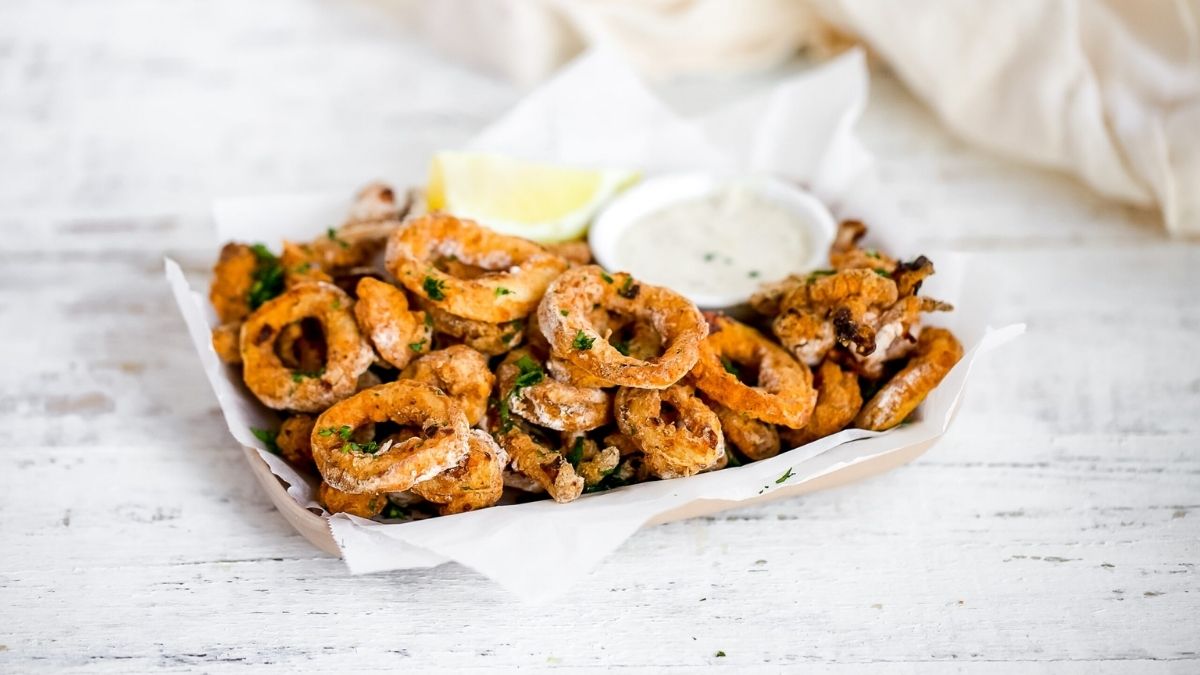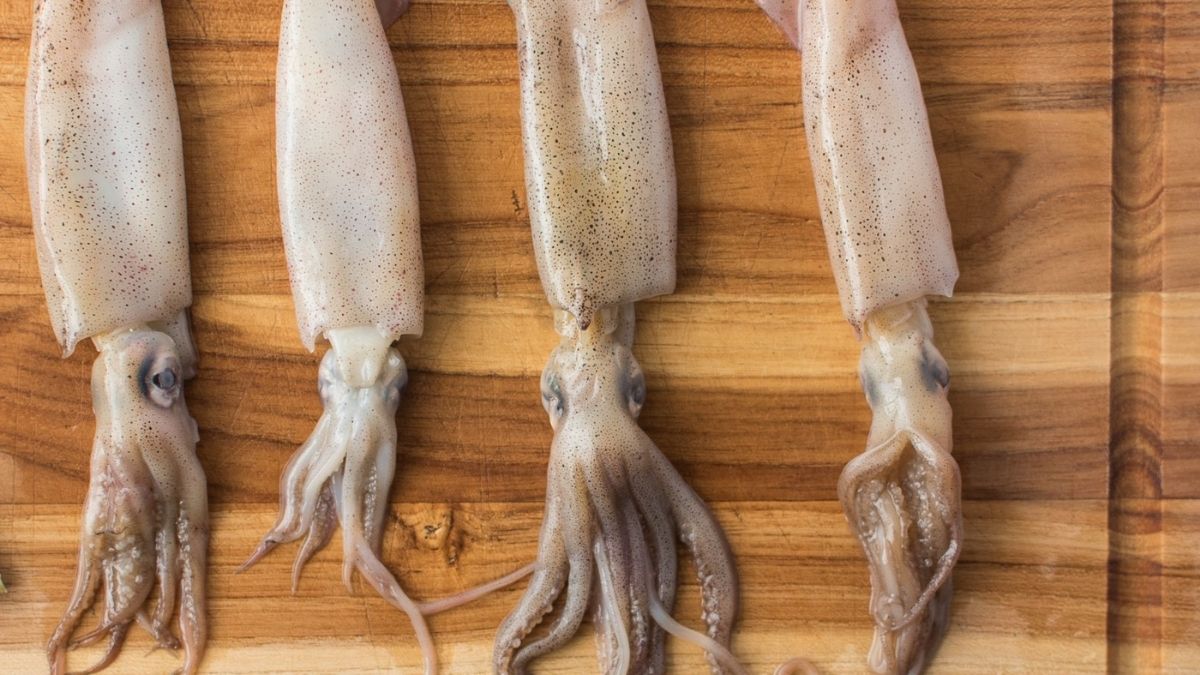Calamari is an Italian word that means “squid.” It usually refers to a battered, deep-fried appetizer served in restaurants and bars in the United States, though some people confuse it with Squid’s primary ingredient. While Squid is prevalent in many Mediterranean nations, it is also widespread throughout Asia.
Squid is used in paella, risotto, soups, and pasta in Spain and Italy, while lulas, grilled entire kebabs of squid rings with bell peppers and onions, are popular in Portugal. Fresh Squid is frequently deep-fried in Korea, then wrapped in lettuce leaves with mustard or chili sauce. Squid is cooked whole and sold at food stalls and stands in several Asian nations, including China, Thailand, Japan, and Taiwan. In Chinese and Southeast Asian cuisine, more intensely flavored Squid can be found in stir-fries, rice, and noodle dishes.
What is Calamari?
More than 300 species of Squid live in the world’s waters, but only a few dozen account for nearly all of the global culinary market. Fresh Squid is a mollusk related to both the cuttlefish and the octopus. It’s sometimes sold as Calamari to make it sound more upscale (and hence more expensive), but there’s no real difference. Squid can grow as long as 80 feet in length. However, most culinary specimens are less than 12 inches long. Like its cousin, the octopus, the Squid has a defense system that emits a dark ink into the water when it detects danger.
In Italian, Calamari refers to Squid. Like “pork” and “beef,” Calamari” is a culinary name for squid meat in English. The breaded and fried calamari appetizer at Italian-American restaurants is the most prevalent squid preparation in the United States. Squid are cephalopods with elongated, soft bodies, long limbs, and tentacles, similar to their cuttlefish and octopus cousins. Squids have long, simple bodies to butcher, leaving a thin cylinder-shaped mass of flesh that can be stuffed or cut into rings and fillets. Squid may grow up to 80 feet in length and are commonly captured and prepared when between an inch and a foot long.
How to Cook Calamari?
To make Calamari, slice the squid body into thin rings and fry for a few minutes over high heat. Grilling, broiling, and deep-frying for a few minutes are all standard cooking methods, and Squid should be cooked for a brief period or for a long time over low heat for delicate Calamari. While the tastiest meat comes from the Squid’s body, the calamari tentacles are also delicious, especially in fried Squid, where they provide more surface area for the golden-brown breading.
Grilling, broiling, sautéing, and deep-frying are all excellent methods for cooking Squid. It can also be consumed raw in sushi. Alternatively, a low-and-slow braise with white wine and garlic, tomato sauce, or curry could be used. Fresh, canned, frozen, dry, and pickled Squid are available. Pasta and risotto can be colored with salty black ink. The body is the major component of flesh; it can be stuffed whole, split into flat sections, or divided crosswise into rings. The tentacles are edible and typically included on a platter of fried Calamari.
10 Popular Calamari Dishes
Squid is a common element in many classic cuisines. The following are ten popular seafood meals from throughout the world.
- Calamari fried Fried calamari rings are a popular dish offered at Italian-American restaurants worldwide, where they’re breaded in flour, seasoned with salt and pepper, and served with lemon wedges and marinara sauce for dipping.
- Squid with salt and pepper. Squid is dredged in cornstarch and fried till crispy in Cantonese cooking, with extra ingredients such as green onions, garlic, ginger, and Shaoxing wine.
- Spaghetti with sepia Nero. Squid ink, white wine, garlic, and parsley make an Italian pasta sauce.
- Paella de Espana. Calamari is frequently served with chorizo, chicken, and other shellfish on saffron and garlic-scented rice.
- Yemista Kalamarakia Calamari’s bodies are left intact and stuffed with a stuffing prepared from rice, fresh veggies, and herbs on the Greek island of Crete. The plump squid stew slowly in a tomato sauce for this Mediterranean specialty.
- Cioppino. One of the most famous squid recipes, this seafood stew was created in the late 1800s when anglers in the Bay Area of California began adding Squid to a delicious tomato broth.
- Kampong. Spicy Korean stew with noodles, vegetables, and seafood such as Squid and shrimp.
- Sansai Ika. Raw squid salad with mushrooms and bamboo shoots from Japan.
- Yakimono. This squid dish is roasted on skewers over charcoal in Japanese yakitori restaurants.
- Ceviche. Ceviche is a dish that changes with the seasons and what’s available. Squid is joint seafood for the Latin meal, along with fish, shrimp, and octopus.
What does Calamari Taste Like?
Compared to octopus and cuttlefish, which have thicker, more savory meat like crab or lobster, Squid has thin, mild flesh. Raw squid meat is smooth and firm, unlike fish and shellfish. Calamari becomes soft and absorbs the aromas it is cooked with when adequately prepared. If not, it will become gummy and bland. The meat has a mild, slightly sweet, almost nutty flavor and is firm and white. The texture of the fried Squid should be firm and chewy but not rubbery. Fried Calamari is typically served with a garlicky aioli or marinara sauce for dipping, and Squid rapidly absorbs the taste of the meal in any preparation.
The flesh of Squid is thinner and milder than that of octopus or cuttlefish. Raw Calamari is smooth but solid, unlike fish or shellfish, and has a lump of more flavorful meat than other seafood selections like lobster or crab. Calamari becomes a delicate piece of meat when properly prepared and cooked, and it will absorb the tastes of other foods if you cook it with them. Calamari can be chewy and bland if there are no other flavors to accompany it.
How to Store Calamari?
The bulk of seafood should not be frozen for an extended time. Squid, however, freezes beautifully. This is why you can buy it frozen at most supermarkets. If you purchase fresh Squid, clean it before freezing it in a zip-top freezer bag. Calamari can be frozen and kept for several months, and Squid that has been cooked can be kept in the refrigerator for a few days. It should be discarded if it is any longer. However, traditional deep-fried Calamari tastes best when eaten right away. After purchasing fresh or frozen Squid, wrap it firmly in plastic wrap and keep it in the coldest part of your refrigerator or on ice. Squid that has been frozen and thawed should be utilized within two days.
Where does Calamari Come from?
Squid can be found in all oceans and seas (except for the Black Sea). Squid species such as Atlantic or European Squid, reef squid, and Japanese flying Squid are fished, cooked, and consumed. Half of the world’s Squid is consumed in Japan, where it is known as ika and is classified with cuttlefish (koika).
Squid can be found in every ocean on the earth save the Black Sea. Although just a few of the 300 squid species are utilized in cooking, many are still harvested, prepared, and consumed worldwide. The European, Atlantic, reef, and Japanese flying squid are among the most often caught squids. Calamari consumption in Japan accounts for half of global consumption. However, in this region of the world, it is known as “ika” and is classified as cuttlefish or koika in Japanese.
Is Calamari a Squid or Octopus?
Octopus and Calamari are frequently mistaken, but their tastes (when eaten raw) and cooking methods are unexpectedly different. Many people believe that Calamari is created from octopus but manufactured from a type of Squid.
From a biological standpoint, Calamari and octopus belong in the same category. Cephalopods include Calamari and octopus. Cephalopods are predatory mollusks that live in the sea. However, various groups of this species live in different environments. Calamari (squids) live in the open ocean and deep water. Octopuses, on the other hand, love dark caves and reefs. Because they are two separate species, it’s not surprising that their physical attributes differ.
The head of a squid is triangular, but the head of an octopus is circular. The arms of an octopus are coated in a row or two of suckers. Squids, like octopuses, have eight arms, but they also have two specialized tentacles and a mantle. Calamari and octopuses vary in that the latter does not have a shell, and Calamari has a shell, which is unusual. Clams and oysters are not my favorite foods, and Calamari’s shell is inside their bodies.
The backbone of Calamari is flexible, and the mantle is supported by this little backbone, sometimes known as a pen. Calamari and octopus are also of varying sizes, and Calamari is often smaller than octopuses. Calamari, for example, can grow up to 12 inches long. There are, of course, more extensive and more extended squid species and Octopuses that range in size from 12 to 36 inches in length.
Conclusion
Calamari is unlike any other seafood, with thin, rough flesh that, when appropriately cooked, can be turned into delicate meat. China and Italy have been frying Calamari for generations. At the same time, Greece stuffs the entire squid cavity with rice and herbs, and Japan has a plethora of raw and cooked calamari recipes. Calamari is likely to be found snuggled in a seafood stew, mixed with noodles, or fried in bite-size bits wherever you go.
Most seafood shops and, depending on your location, supermarket stores have fresh Calamari. Calamari harvested in the United States is the most prevalent option. However, Squid imported from Asia is also available, and Squid freezes well if you can’t get your hands on fresh Calamari. Calamari is typically sold pre-sliced or whole and cleaned.


